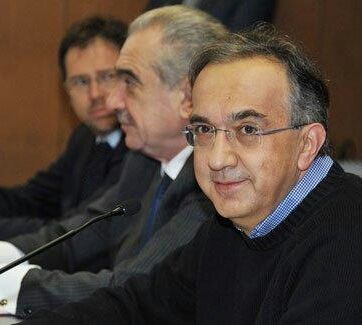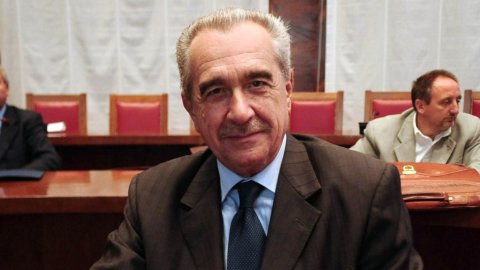Today the largest production center for cars Premium of FCA, the Maserati, is the Turin plant of Grugliasco, which Fiat took over in August 2009 from the former Carrozzerie Bertone, under extraordinary administration, allowing its relaunch and the return to work of the 1100 workers who were on zero-hour layoffs for over five years.
The Grugliasco plant, already conceived by Bertone for the production of sports and niche cars, was the ideal location, once renovated, to be able to manage the production of high-end cars such as the Maserati in full autonomy.
The industrial project, thanks to the proximity between Grugliasco and Mirafiori, less than 5 km, also envisaged technological and logistic synergies between the two plants, creating an automotive production pole for Premium cars, a real “automotive luxury boutique".
Marchionne's goal, also thanks to the opening up of the American market with the acquisition of Chrysler, was to quickly bring Maserati production from the previous levels of 5-6 thousand cars a year in Modena to over 50 thousand units a year.
To obtain it, however, it was necessary to be able to integrate philosophy handmade that had characterized the historical production of Maserati with a new approach industrial to radically improve the technical-organizational processes and the livability in the factory.
A new vision industrial of the factory, of which Marchionne was the architect at Fiat, where the heavy and repetitive work is performed by robots, noise is almost totally absent, the spaces are large and bright, ergonomics is the pillar of the organization of the Work. With the methodology of WCM (World Class Manufacturing) the new vision industrial has dismantled the traditional hierarchical structures and organizational complexity, by definition unproductive and harmful, replacing them with an organization that has distributed decision-making power horizontally to all collaborators (workers, technicians, managers) who are the most suitable to exercise them at various levels.
To obtain these results, new “factory rules” with union consent and the involvement and participation of workers.
In November and December 2009 Marchionne, as CEO of Chrysler, signs with the powerful auto unions across the Atlantic (the Union Auto Workers and the Canadian Auto Workers) the first industrial plan of his American management which envisaged the launch of 16 new car models, a plan made possible by a drastic reduction in labor costs and the introduction of greater flexibility in working hours, in the use of holidays and paid leave. The union agreements will be put to a referendum among American and Canadian workers and approved by majorities of more than 95 percent.
When in Pomigliano, in June 2010, and in Mirafiori, in December of the same year, in order to be able to start the production of the new models and guarantee employment levels, the agreements that fix the new ones will be signed “rules of blacksmithsca" only with the reformist and participatory metalworkers' unions of Fim-Cisl, Uilm-Uil and Fismic in the face of the refusal of Fiom-Cgil which had taken an antagonistic and total break with the union table, it will be Marchionne himself who will ask that the signed trade union agreements were subjected to referendum scrutiny by the workers concerned.
There will be two referendums that will have effects “evocative” in the union relations system not only of the company but of the country system.
In the following years, in moments of tension at various territorial or company union tables, recourse to workers with a referendum as in Fiat would be recalled several times out of threat or fear.
At the Pomigliano Marchionne referendum, and with him many of the members of the GEC (Group Executive Council), the decision-making committee made up of Fiat's top management, he was convinced that the union agreement would be approved by the vast majority of workers, as in Chrysler.
On the night of 22 June 2010, when I communicated to him from Pomigliano (at the time I was the industrial relations manager of Fiat Group Automobiles), the final results that gave the victory of the yes to the agreement with 63%, for many minutes I heard him , to put it mildly, “very irritated”. I also reminded him that it was the first time in Fiat that a trade union agreement had been approved by referendum with such a wide yes margin, indeed in most cases they were rejected, such as, for example, not later than a year before the workers of the Meccaniche di Mirafiori had canceled the trade union agreement which established new work shifts, an agreement which had been signed by all the unions, including Fiom-Cgil.

Six months later, the victory of the yeses in the Mirafiori referendum was thus considered a success, even though the favorable votes barely exceeded 54% of the total workers and, among the workers, the yeses won with a gap of just 9 ballots.
The referendum season ended in Grugliasco the following May.
Unlike the Pomigliano and Mirafiori plants where Fiom was in a clear minority, both in terms of members and union representatives, compared to the other metalworkers' unions, the Grugliasco plant of the former Carrozzerie Bertone was one of the Fiommine strongholds in the Turin area with its "dominant" majority of over 700 members out of 1100 workers and 10 union representatives out of 15.
The project to restructure the plant with an investment of over 600 million euros and to relaunch production with the allocation of the new Maserati cars could not however disregard the application also to the workers of Grugliasco of the provisions of the Pomigliano and Mirafiori agreements, whose essential points, we recall, provided for the maximum use of the systems with the gradual transition to 18 shifts, an additional limit of 120 hours of overtime per year, the reduction of 10 minutes of work breaks from 40 to 30 minutes over 7h30 ' of daily work, the postponement of the half-hour canteen at the end of the shift, the adoption of measures to combat absenteeism, liability clauses in the event of a strike.
The positions of both sides, Fiat and Fiom, appeared irreconcilable from the outset.
For Fiat, excessively giving in to the union demands of Fiom, which proposed its own organizational platform for the resumption of production, evidently entailed the risk of having to renegotiate with the other metalworkers' unions what was obtained by the majority in Mirafiori and Pomigliano.
The Turin-based Fiom was also aware that if an agreement had not been reached in a short time, Fiat would have abandoned the project and started the search for a new allocation for the investment, where Fiom was in the minority. There were also fears that Fiat would return the former Bertone to extraordinary administration.
The question of the liability clauses which, for Fiom, harmed the constitutional right to strike remained insurmountable. Indeed, precisely during the negotiation phases, Fiom Nazionale filed an appeal under Article 28 of the Workers' Statute against Fiat to the Labor Judge of Turin for the alleged anti-union nature of the Pomigliano and Mirafiori agreements (however, the appeal was rejected by the Judge the following July ).
Marchionne nonetheless asked me to find a solution that would also involve Fiom in some way, because it would have been impossible to carry out the Maserati project in Grugliasco without the consent of the union with the largest number of workers members.
The solution was found with company union representation at a unitary level: the draft agreement presented by the company, which called in whole the points of the Mirafiori agreement, would have been presented by the union representatives to the workers' assembly and submitted to a vote by referendum.
At the workers' assembly, the union representatives of Fiom also expressed their efforts to approve the agreement, with Fiom confirming that the final decision rested with the union delegates: a position that someone defined as "Fiom with variable geometry".
On 2 May 2011, with a plebiscitary percentage close to 90% – 886 yes out of 1010 voters – the workers of the former Bertone said yes to restart the lines of the Grugliasco factory.
Two days later, an agreement was signed at the Industrial Union of Turin with the company union representatives, obviously including those of Fiom in the majority, which guaranteed the necessary conditions to give the green light to the investment plan envisaged by the project.
The Grugliasco plant was named after the lawyer. Gianni Agnelli with the acronym AGAP (Avv. Gianni Agnelli Plant) and today has more than 2000 employees who produce the Maserati Quattroporte and Ghibli.





